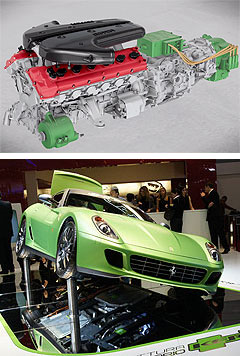Future models - Ferrari - F70Beijing show: Ferrari’s V12 hybrid may power next EnzoFerrari unveils more efficient Hy-KERS hybrid system for mid-rear layout at Beijing26 Apr 2012 FERRARI wheeled out an updated version of its Hy-KERS (standing for hybrid kinetic energy recovery system) drivetrain at this week’s Beijing motor show – providing the first public glimpse of what is expected to propel the Prancing Horse’s Enzo successor. In contrast with the system’s previous outing at the 2010 Geneva motor show, where it was configured for a front-engine layout and fitted to a bright green 599 coupe, the V12-based system was displayed in a glass case at Beijing and packaged for a mid-rear installation. Given the mid-engined 458 is built around a V8 and the V12-powered F12 Berlinetta and FF use a traditional front engine layout, it follows that the drivetrain shown at Beijing is destined for Ferrari’s next limited-edition flagship model, dubbed F70. The Hy-KERS system – said to maintain a car’s weight distribution while lowering its centre of gravity – consists of an electric motor attached to the dual-clutch transmission, providing motive power or acting as a fast charger for the batteries under regenerative braking. Compared with the Hy-KERS system shown in 2010, which was claimed to reduce CO2 output by 30 per cent compared with an equally powerful purely internal combustion engine, the latest incarnation ups that figure to 40 per cent.  Left: Ferrari Hy-KERS drivetrain. Below: 2010 Hy-KERS concept.Ferrari claims efficient integration of the motor is achieved with no increase in the size or weight of the drivetrain, with smaller, lighter components that bring it closer to achieving its goal of increasing power by 1kW for every extra kilogram the system adds to a car’s weight. Left: Ferrari Hy-KERS drivetrain. Below: 2010 Hy-KERS concept.Ferrari claims efficient integration of the motor is achieved with no increase in the size or weight of the drivetrain, with smaller, lighter components that bring it closer to achieving its goal of increasing power by 1kW for every extra kilogram the system adds to a car’s weight.Trickle-down technology from Formula 1 is said to result in the motor and its electronic control unit providing precise torque management that can be used to improve a car’s dynamic characteristics in terms of traction control and brake distribution. A motor is also bolted to the front of the engine and provides power to engine ancillaries such as the power steering, brake servo and air-conditioning systems, altering its drag on the engine based on the level of energy in the batteries. Ferrari says the system is now ready to transition from the experimental phase to the development phase, which will begin in coming months. It has been reported that select customers will be privy to an unveiling of Ferrari’s next flagship before the end of this year and ahead of its expected public debut at either the Detroit motor show next January or the Geneva show two months later. Mystery still shrouds the Enzo replacement, but it will no doubt be the fastest, most powerful car in Ferrari’s history, eclipsing even the F12 Berlinetta’s sky-high 544kW/690Nm power and torque outputs and 1m 23s lap time of the brand’s famous Fiorano test circuit – almost two seconds faster than the Enzo achieved a decade ago. Lightweight carbon-fibre construction is expected and like previous limited-run Ferrari flagships, the Enzo replacement will built in left-hand drive only, meaning it will not be officially sold here. Such exotics do slip through the net but are difficult, if not impossible to register for road use.  Read more19th of March 2012  Ferrari Enzo successor within a yearSelect few to preview next flagship Ferrari hypercar ahead of expected 2013 reveal14th of March 2012  Ferrari 458 Spider to cost $590,000Deliveries of Ferrari 458 Spider folding hard-top to commence mid-year from $590k1st of March 2012  Geneva show: Ferrari’s F12 Berlinetta laid bareFerrari 599 successor emerges as Prancing Horse’s fastest, most powerful road car16th of February 2012  Geneva show: Ferrari finesses CaliforniaPrancing Horse brand announces lighter, quicker and more powerful 2012 California |
Click to shareFerrari modelsResearch Ferrari Motor industry news |
















Facebook Twitter Instagram